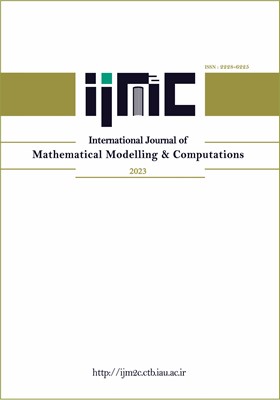Exploration of COVID-19 Pandemic Using Variety of Frequency Tables
Subject Areas : International Journal of Mathematical Modelling & Computations
Mohammed Mohammed
1
![]() ,
Mohd Adam
2
,
Hassan Ahmed
3
,
H. D. ‎Salihu
4
,
Mohd Adam
2
,
Hassan Ahmed
3
,
H. D. ‎Salihu
4
1 - Department of Mathematics and Statistics, Federal University of Kashere,P.M.B 0182,
Gombe State, Nigeria
2 - Institute for Mathematical Research, Universiti Putra Malaysia.
3 - Department of Statistics and Operations Research, Modibbo Adama University of Technology, Yola, Adamawa State, Nigeria.
4 - Department of Mathematics and Statistics, Federal University of Kashere,P.M.B 0182, Gombe State, Nigeria
Keywords: Coronavirus, Pandemic, Positive Cases, Death Cases, Recoveries, Exploratory Data Analysis, Discrete Frequency Table,
Abstract :
The coronavirus disease was first discovered in Malaysia on the 25th of January, 2020. The number of positive cases remained stable until March 2020, where a large spike emerged. Different exploratory data analysis tools need to be used to easily observe the trend of coronavirus infections and ascertain the end of the pandemic. Also, the growth rate of the pandemic seems to be under-reported in many countries due to some issues. In this research, we explored the reported COVID-19 data using different discrete frequency tables. The positive cases, deaths, and recoveries were organized in general cases, cumulative cases and 14 days moving cases frequency tables. The reported positive cases were displayed according to the states as states' new cases, cumulative cases, and 14 days moving cases frequency tables. The end of the pandemic can be detected when there is no infection for 14 consecutive days and was determined in the country as a whole using the cumulative cases and the 14 days moving cases general frequency tables. Whereas in the states, the states' cumulative cases and the 14 days moving cases frequency tables were used to detect the end of COVID-19 pandemic.
[1] J. A. Backer, D. Klinkenberg and J. Wallinga, Infections among travellers from Wuhan, China, 2028
January 2020, EuroSurveillance, 25 (5) (2020) pii=2000062.
[2] M. Battegay, R. Kuehi, S. Tschudin-Sutter, H. H. Hirsch, A. F. Wilmer and R. A. Neher, 2019-
Novel Coronavirus (2019-nCoV): Estimating the case fatality rate-a word of caution, Swiss Medical
Weekly, 150 (2020) w20203.
[3] D. Chan et al., Epidemiological and clinical characteristics of novel coronavirus infections involving
13 patients outside Wuhan, China, Journal of the American Medical Association, 323 (11) (2020)
1092–1093.
[5] P. Colson, J. M. Rolain and D. Raoult, Chloroquine for the 2019 novel coronavirus, International
Journal of Antimicrobial Agents, 55 (2020) 105923.
[6] Garda World news. Malaysia: First cases of 2019-nCoV confirmed January 25, Garda World, https://www.garda.com/crisis24/news-alerts/308496/
malaysia-first-cases-of-2019-ncov-confirmed-january-25 (accessed April 14, 2020).
[7] A. C. Ghani et al., Methods for estimating the case fatality ratio for a novel emerging infectious
disease, American Journal of Epidemiology, 162 (5) (2005) 479–486.
[8] N. Imai, I. Dorigatti, A. Cori, C. Donnelly, S. Riley and N. M. Ferguson, Estimating the Potential
Total Number of Novel Coronavirus Cases in Wuhan City, China, Imperial College London, 2 (2020).
[9] Independent News. Coronavirus: Malaysia cases rise by 190 after mosque event as imams
urge online services, Independent News, https://www.independent.co.uk/news/world/asia/
coronavirus-malaysia-cases-southeast-asia-mosque-islam-a9403816.html (accessed April 14,
2020).
[10] JHU. Coronavirus COVID-19 Global Cases. Center for Systems Science and Engineering
(CSSE) at Johns Hopkins University (JHU), https://coronavirus-resources.esri.com/datasets/
bda7594740fd40299423467b48e9ecf6 (accessed May 6, 2020).
[11] S. M. Kissler, C. Tedijanto, E. Goldstein, Y. H. Grad and M. Lipsitch, Projecting the
transmission dynamics of SARS-CoV-2 through the postpandemic period, Science, (2020),
doi:10.1126/science.abb5793.
[12] Malaysiakini news. Covid-19 in Malaysia, Malaysiakini, https://newslab.malaysiakini.com/
covid-19/en (accessed May 6, 2020).
[13] MOH, COVID-19 (Maklumat Terkini), Ministry of Health (MOH) Malaysia, http://web.archive.
org/web/20200406131359/http://www.moh.gov.my/index.php/pages/view/2019-ncov-wuhan (accessed April 09, 2020).
[14] MOH, COVID-19 (Maklumat Terkini), Ministry of Health (MOH) Malaysia, http://www.moh.gov.
my/index.php/pages/view/2019-ncov-wuhan (accessed April 09, 2020).
[15] M. B. Mohammed, M. B. Adam, N. Ali and H. S. Zulkafli, Improved frequency tables measures of
skewness and kurtosis with application to weather data, Communications in Statistics - Theory and
Methods, (2020), doi:10.1080/03610926.2020.1752386.
[16] M. B. Mohammed, M. B. Adam, H. S. Zulkafli and N. Ali, Improved frequency table with application
to environmental data, Mathematics and Statistics, 8 (2) (2020) 201–210.
[17] S. A. Nawaz et al., A hybrid approach to forecast the COVID-19 epidemic trend, PLoS ONE, 16
(10) (2021) e0256971, https://doi.org/10.1371/journal.pone.0256971
[18] A. Singh, What is the size of the Covid-19 epidemic in Malaysia?, Malaysiakini, https://www.
malaysiakini.com/news/519264, (accessed April 23, 2020).
[19] G. Toga, B. Atalay, and M. D. Toksari. COVID-19 Prevalence Forecasting using Autoregressive Integrated Moving Average (ARIMA) and Artificial Neural Networks (ANN): Case of Turkey. Journal
of infection and public health, 14 (1) (2021) 811–816.
[20] R. Verity, L. C. Okell, I. Dorigatti, P. Winskill, C. Whittaker, N. Imai and N. M. Ferguson, Estimates
of the severity of coronavirus disease 2019: a model-based analysis, The Lancet Infectious Diseases,
(2020), doi:10.1016/s1473-3099(20)30243-7.
[21] WHO, Q & A on coronaviruses (COVID-19), World Health Organization, https://www.who.int/
news-room/q-a-detail/q-a-coronaviruses (accessed April 17, 2020).
[22] WHO, WHO Director-General’s opening remarks at the media briefing on COVID-19,
11 March 2020. World Health Organization https://www.who.int/dg/speeches/detail/
who-director-general-s-opening-remarks-at-the-media-briefing-on-covid-19---11-march-2020
(accessed April 14, 2020).
[23] Wikipedia contributors, COVID-19 pandemic in Malaysia, Wikipedia, The Free Encyclopedia, https://en.wikipedia.org/w/index.php?title=COVID-19_pandemic_in_Malaysia&oldid=
954924307 (accessed May 6, 2020).


